Websadroit is a full-service web development and digital marketing agency. We offer everything from web design and development to SEO and online marketing services. Contact us today to learn more!
Don't wanna be here? Send us removal request.
Text
The Role of Hybrid App Development Companies for a Top-Notch Mobile Experience
In the ever-evolving landscape of mobile technology, businesses strive to deliver seamless and engaging user experiences across platforms. Hybrid app development companies play a pivotal role in this endeavor, offering comprehensive solutions to create versatile and high-performing mobile applications.
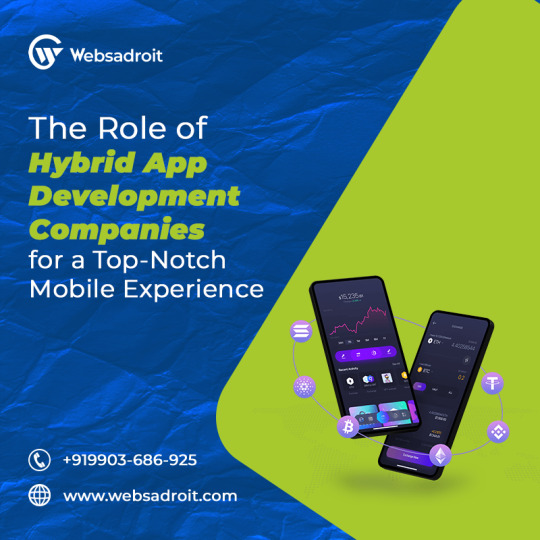
In this blog post, we'll explore the significance of hybrid mobile app development services and how partnering with a hybrid app development company can elevate your mobile strategy to new heights.
Understanding Hybrid Mobile App Development Services
Hybrid mobile app development involves creating applications that can run on multiple platforms, such as iOS, Android, and the web, using a single codebase. Unlike native apps, which are built specifically for a particular platform, hybrid apps leverage web technologies like HTML, CSS, and JavaScript to achieve cross-platform compatibility. These app development companies specialize in building and deploying these versatile applications, offering a range of services tailored to meet the unique needs of businesses and their target audiences.
Versatility and Cost-Effectiveness
One of the primary advantages of hybrid mobile app development is its versatility and cost-effectiveness. This makes hybrid app development an attractive option for startups and small businesses with limited resources, allowing them to reach a broader audience without breaking the bank.
Seamless User Experience
Hybrid apps offer a seamless user experience across platforms, providing consistent performance and functionality regardless of the device or operating system. Users can enjoy the same features and capabilities whether they're accessing the app on their smartphone, tablet, or desktop computer. This uniformity enhances user satisfaction and engagement, driving retention and loyalty over time.
Faster Time-to-Market
Speed is essential in today's fast-paced digital landscape, and hybrid app development enables businesses to bring their apps to market more quickly. With a single codebase and streamlined development process, these app development companies can expedite the deployment of new features and updates, allowing businesses to stay ahead of the competition and capitalize on emerging trends and opportunities.
Access to Native Device Features
Contrary to popular belief, hybrid apps can access native device features such as GPS, camera, and push notifications, thanks to plugins and frameworks like Apache Cordova and React Native. This allows businesses to create rich and interactive experiences that take full advantage of the capabilities of modern smartphones and tablets, without sacrificing cross-platform compatibility.
Why Partner with a Hybrid App Development Company?
Expertise and Experience
Hybrid app development companies possess the expertise and experience needed to navigate the complexities of cross-platform development successfully. Their team of skilled developers, designers, and project managers collaborate closely with clients to understand their business objectives and deliver tailored solutions that meet their needs and exceed their expectations.
Customized Solutions
Every business is unique, and these companies recognize the importance of customizing solutions to fit the specific requirements of each client. Whether you're looking to build a mobile e-commerce app, a social networking platform, or a productivity tool, a hybrid app development company can help you bring your vision to life with a bespoke application tailored to your business goals and target audience.
From bug fixes and security updates to feature enhancements and platform updates, they are committed to helping you maximize the value of your investment and achieve long-term success.
Embrace the Power of Hybrid App Development Companies
Hybrid mobile app development services offer a compelling solution for businesses looking to create versatile, cost-effective, and high-performing mobile applications. By partnering with a hybrid app development company, businesses can leverage the expertise, experience, and resources needed to bring their mobile strategy to life successfully.
Whether you're a startup looking to disrupt the market or an established enterprise seeking to enhance your mobile presence, embracing hybrid app development can unlock a world of opportunities and propel your business to new heights in the digital age.
0 notes
Text
Navigating the Journey When You Hire Mobile App Development Companies-An Inside View
In the ever-evolving landscape of technology, mobile applications have become an integral part of our daily lives. Behind the sleek interfaces and seamless functionalities lie the complexities of the mobile app development process. In this blog post, we take an inside look at the journey from ideation to deployment, unraveling the intricate steps that are involved when you hire mobile app development companies to bring your favorite apps to life.
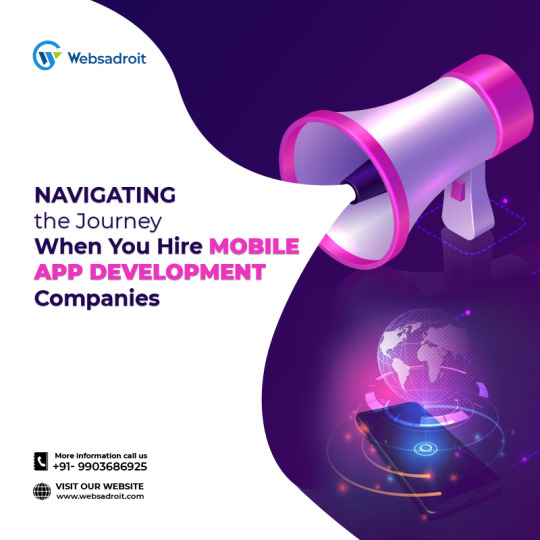
1. Ideation and Conceptualization
Every app begins with an idea—a spark of creativity that addresses a need or solves a problem. The ideation phase is about refining this concept, understanding the target audience, and conducting market research. Developers collaborate with stakeholders to define the app's purpose, features, and overall vision.
2. Market Research and Competitor Analysis
Understanding the competitive landscape is crucial. Developers delve into market research and analyze existing applications to identify gaps and opportunities. This analysis guides decision-making on features, design elements, and user experience to ensure the app stands out in a crowded marketplace.
3. Planning and Wireframing
With a clear concept in hand, the planning phase begins. You hire mobile app development companies for you to create a roadmap, outlining the app's architecture, features, and functionalities. Wireframing tools are employed to sketch a basic visual representation of the app's layout and user interface. This serves as a blueprint for the development team.
4. Designing the User Interface (UI) and User Experience (UX)
Aesthetics and user experience are paramount in mobile app development. UI/UX designers work on creating visually appealing and user-friendly interfaces. They consider factors such as color schemes, navigation flows, and accessibility to ensure a seamless and enjoyable user experience.
5. Prototyping
Before diving into full-scale development, a prototype is often built. This interactive model allows stakeholders to test the app's basic functionalities and provide feedback. Prototyping is a valuable step in refining the user experience and catching potential issues early in the process.
6. Development
This is where the coding magic happens. Developers select the appropriate technology stack, considering factors like platform (iOS, Android, or cross-platform), programming languages, and frameworks. The app's frontend and backend are constructed, and functionalities are integrated, often following an agile development methodology for flexibility and adaptability.
7. Testing
Quality assurance is integral to the mobile app development process. Testers rigorously examine the app for bugs, performance issues, and usability concerns. Various testing methods, including unit testing, integration testing, and user acceptance testing, ensure a robust and reliable end product.
8. Iterative Development
Testing doesn't mark the end of development; it's a cyclical process. Feedback from testing phases leads to iterative development, where improvements and refinements are made. This continuous feedback loop is essential for delivering a polished and high-quality app.
9. Deployment to App Stores
Once the app meets quality standards and stakeholder expectations, it's ready for deployment. For iOS apps, this involves submission to the Apple App Store, while Android apps head to the Google Play Store. Developers adhere to each platform's guidelines, ensuring a smooth submission process.
10. Post-Launch Support and Maintenance
The journey doesn't end with deployment. Continuous support and maintenance are crucial. Developers monitor user feedback, address emerging issues, and roll out updates to enhance features or fix bugs. This phase ensures the app stays relevant and performs optimally in a dynamic environment.
11. Marketing and Promotion
Even the most brilliantly developed app needs effective marketing to gain visibility. Marketing teams work on strategies to promote the app, utilizing social media, content marketing, and other channels. Creating a buzz around the app increases downloads and user engagement.
12. Analytics and User Feedback Analysis
Post-launch, analytics tools come into play. Developers and stakeholders analyze user data to gain insights into user behavior, preferences, and usage patterns. This data-driven approach helps in making informed decisions for future updates and enhancements.
13. Security Measures
In an era of increasing cyber threats, ensuring the security of user data is paramount. Developers implement robust security measures, including data encryption, secure authentication, and adherence to industry standards, to protect user information.
14. Scaling for Growth
As the app gains popularity, scaling becomes a consideration. Developers must ensure that the infrastructure can handle increased user loads. Scalability is not only about accommodating more users but also about optimizing performance and maintaining a positive user experience.
15. Emerging Technologies Integration
To stay ahead, developers explore and integrate emerging technologies. Augmented reality (AR), virtual reality (VR), artificial intelligence (AI), and the Internet of Things (IoT) are examples of technologies that can enhance the functionality and user experience of mobile apps.
In all, the mobile app development journey is a multifaceted process that demands creativity, technical prowess, and meticulous attention to detail. From the initial spark of an idea to the continuous improvement post-launch, each phase plays a crucial role in delivering an app that not only meets but exceeds user expectations. As technology continues to evolve, the mobile app development landscape will undoubtedly witness new trends and methodologies, but the essence of creating innovative, user-centric applications will remain at its core.
0 notes
Text
Unlock the Power of Custom Logo Design Services- Transforming Your Brand Identity
In the vast landscape of business and marketing, where first impressions are often visual, a custom logo serves as the heartbeat of brand identity. It is not merely a graphical representation; it encapsulates the essence, values, and aspirations of a brand. In this blog post, we will delve into the profound influence of custom logos on brand identity, exploring how these unique symbols go beyond aesthetics to leave an indelible mark on the minds of consumers making it imperative for you to hire custom logo design services.
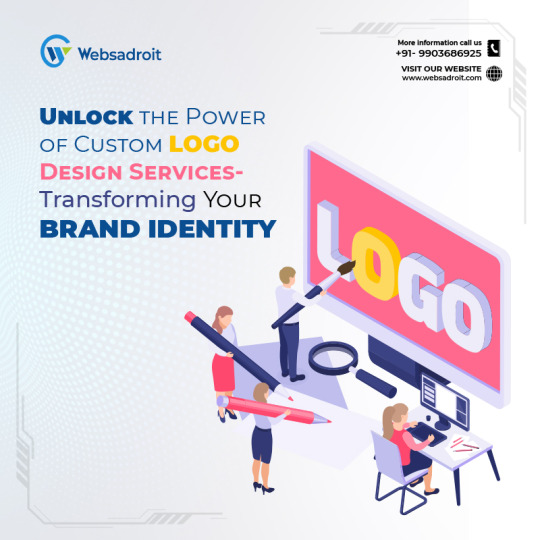
The Power of Visual Communication
Humans are inherently visual beings, and the impact of visual elements on our perception is undeniable. A custom logo acts as the visual ambassador of a brand, communicating its personality and values without the need for words. It serves as a silent, yet powerful communicator, instantly evoking emotions and associations tied to the brand.
Instant Recognition
A well-designed custom logo ensures instant recognition in a crowded market. Think about iconic logos like the golden arches of McDonald's or the swoosh of Nike—these symbols are so ingrained in our collective consciousness that we recognize them in an instant. The ability to be identified swiftly is a testament to the strength of a brand's visual identity, all encapsulated within its custom logo.
Creating a Memorable Impression
In a world bombarded by information, creating a lasting impression is challenging. A custom logo, when thoughtfully crafted, has the potential to etch itself into the memory of consumers. This memorability fosters brand recall, influencing buying decisions and cultivating a sense of loyalty among customers.
Distilling Brand Values into Design
A custom logo is not a haphazard combination of shapes and colors; rather, it is a carefully curated representation of a brand's values and mission. The design elements used by custom logo design services are chosen with meticulous consideration to convey specific messages, making the logo a silent storyteller.
Symbolism and Metaphors
Every curve, color, and symbol in a custom logo is pregnant with meaning. Symbols and metaphors embedded in logos can evoke emotions, tell stories, and convey abstract concepts. For example, the arrow in Amazon's logo is not just a design element; it stands for the company's commitment to delivering everything "from A to Z."
Color Psychology
Colors wield a powerful influence on human psychology, and custom logos use this phenomenon to convey emotions and elicit responses. Blue may evoke trust and reliability (as seen in the logos of Facebook and IBM), while red may symbolize energy and passion (as in the logos of Coca-Cola and Netflix). The strategic use of colors in a custom logo is a deliberate attempt to influence how the brand is perceived.
Setting Apart from the Competition
In a marketplace teeming with competitors, differentiation is key. A custom logo serves as a brand's unique fingerprint, distinguishing it from others in the same industry. It is a visual cue that signals not only what a brand stands for but also why it is different from the rest.
Building Brand Authenticity
Customers today are discerning and value authenticity. A custom logo, when aligned with a brand's genuine values and mission, becomes a beacon of authenticity. It signals to consumers that the brand is not just selling a product or service but is driven by a deeper purpose.
Establishing a Niche
A well-crafted custom logo can convey the niche or specialization of a brand. For example, a sleek and modern logo may indicate a tech-savvy company, while a vintage-inspired design could evoke a sense of tradition and heritage. This visual shorthand helps consumers quickly understand what a brand stands for.
Flexibility in Adaptation
A brand is not static; it evolves over time. A custom logo, when designed with flexibility in mind, can seamlessly adapt to the changing dynamics of a brand without losing its core identity.
Adaptability across Platforms
In the digital age, where a brand interacts with consumers through various platforms, a custom logo must be adaptable. It should look equally impressive on a website, a mobile app, or a billboard. The scalability and adaptability of a logo ensure consistent brand representation across diverse mediums.
Evolution without Losing Identity
As a brand grows and evolves, so too should its visual identity. A custom logo that can undergo subtle changes while keeping its core elements allows a brand to stay relevant and contemporary. Think about how Apple's logo has evolved over the years, reflecting the company's evolution without losing its fundamental identity.
To Sum Up- The Legacy of a Custom Logo
In the grand tapestry of brand building, a custom logo is not a mere accessory; it is the thread that weaves the narrative of a brand's identity. From instant recognition to conveying values and fostering authenticity, the influence of a well-designed logo is immeasurable.
As businesses navigate the ever-changing landscapes of consumer preferences and market trends, the enduring power of a custom logo to encapsulate the soul of a brand remains steadfast. It is a visual manifesto, a timeless symbol that transcends trends and fads, leaving an indelible mark on the hearts and minds of consumers. In the end, a custom logo is not just an image; it is the living embodiment of a brand's journey, aspirations, and the promise of what is yet to come.
0 notes
Text
15 Top Use Cases Where Best ReactJS Development Services Excel
React, the open-source JavaScript library developed by Facebook, has gained immense popularity in web development due to its flexibility, performance, and strong developer community. It excels in a wide range of development projects thanks to its component-based architecture, efficient rendering with the virtual DOM, and the support of a vast ecosystem of libraries and tools. Here are 15 types of development projects where the best ReactJS development services truly excel:
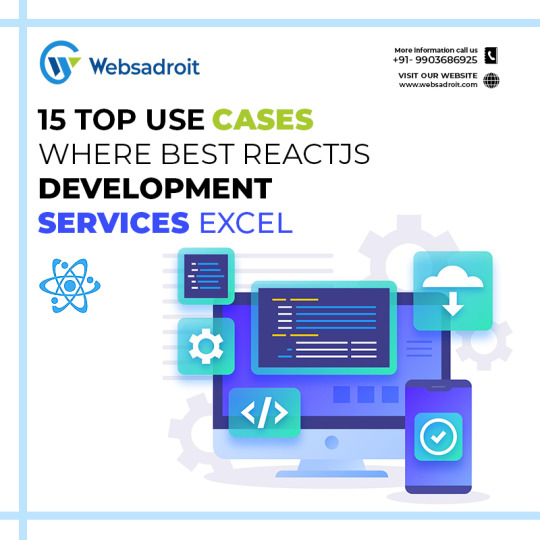
1. Single-Page Applications (SPAs)
React is renowned for building SPAs. Its component-driven architecture makes it possible to create reusable UI components. Such a feature makes it easier to manage complex user interfaces. React's virtual DOM efficiently updates only the parts of the page that change, resulting in a smooth user experience and faster load times.
2. E-commerce Websites
E-commerce platforms require dynamic and real-time updates. React's ability to handle complex user interfaces, product catalogues, shopping carts, and interactive features makes the best ReactJS development services excellent for building high-performance e-commerce websites.
3. Content Management Systems (CMS)
React is well-suited for developing intuitive admin dashboards for content management systems. It provides the flexibility needed to handle content creation, editing, and publishing, making it easier for content managers to work efficiently.
4. Progressive Web Apps (PWAs)
PWAs aim to provide a native app-like experience in the web browser. React's mobile-friendly design philosophy makes it a perfect fit for building PWAs that work seamlessly on various devices and offer features like offline support and push notifications.
5. Data Dashboards
Data visualization dashboards, used in business intelligence and data analysis, benefit greatly from React's component-based structure. React can be integrated with data visualization libraries like D3.js to create interactive and informative dashboards.
6. Cross-Platform Mobile Apps (React Native)
React Native, which is a framework with React as its base, allows developers to build native mobile applications for both iOS and Android using a single codebase. Such flexibility reduces development time and costs while maintaining a native app's performance, look and look-and-feel.
7. Social Media Platforms
Social media apps require frequent updates and dynamic content rendering. React's virtual DOM efficiently manages these updates, ensuring a smooth user experience in applications with complex interactions and real-time content.
8. Real-Time Collaboration Tools
Applications that involve real-time collaboration, such as collaborative document editors, project management tools, and chat applications, benefit from React's ability to handle dynamic data updates without requiring page reloads.
9. Online Learning Platforms
Online learning platforms can leverage React's interactive UI components to create engaging courses. Features like quizzes, video streaming, discussion forums, and interactive lessons can be implemented seamlessly.
10. Internet of Things (IoT) Dashboards
React can build dashboards in the IoT domain for monitoring and controlling IoT devices. Its capability to handle real-time data and updates is crucial for managing connected devices efficiently.
11. Booking and Reservation Systems
React can create booking and reservation systems for various industries, including travel, hospitality, and events. These systems require real-time availability updates and dynamic user interactions, which React handles well.
12. Healthcare Applications
React's ability to manage complex user interfaces makes it suitable for building healthcare applications such as electronic health record systems, telemedicine platforms, and health tracking apps that require a smooth and user-friendly experience.
13. Finance and Banking Applications
Security and performance are critical in finance applications. React's strong community support and libraries like Redux for state management make it reliable for building secure and responsive financial tools, including online banking platforms and financial analysis tools.
14. Marketplace Platforms
Building online marketplaces where users can list, buy, and sell products or services demands a robust and scalable front end. React's component reusability and efficient rendering make it an excellent choice for creating marketplace applications.
15. Gaming Dashboards and Admin Panels
React's ability to create responsive and dynamic user interfaces is valuable in developing gaming dashboards and admin panels. These panels allow game developers to monitor player data, analyze gameplay metrics, and manage in-game content efficiently.
In conclusion, React's versatility, performance, and robust community support make it an ideal choice for various development projects across different industries. Whether you're building a dynamic web application, a cross-platform mobile app, or a real-time collaboration tool, React provides the tools and capabilities needed to excel in modern web and mobile development. By harnessing React's strengths, developers can create powerful, user-friendly applications that meet the demands of today's digital landscape.
0 notes
Text
Why Build Hybrid Apps and What To Look For In A Hybrid App Development Company
In the ever-evolving landscape of mobile app development, businesses face a critical decision: whether to develop native apps or opt for hybrid solutions. Hybrid apps have emerged as a compelling choice, blending the best of both worlds and offering a cost-effective and efficient solution for reaching a wider audience across multiple platforms, provided you hire the right hybrid app development company. In this article, we will explore why you should consider building hybrid apps and provide guidance on what to look for in a hybrid app development company.
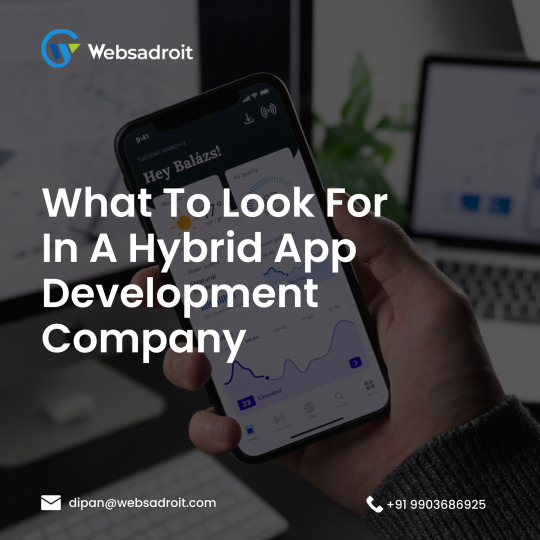
The Reasons Behind Choosing Hybrid Apps
Hybrid apps are basically mobile applications that combine elements of both native mobile and web applications. The technology used for the same is standard web technologies like HTML, CSS, and JavaScript. They are then encapsulated within a native containers. Such an approach allows them to run on multiple platforms, such as iOS, Android, and the web. This approach has gained popularity for several compelling reasons:
Hybrid Apps Can Run Across Platforms
One of the most significant advantages of hybrid apps is their ability to run on multiple platforms with a single codebase. Such universal interoperability significantly reduces development time and costs. Doing so makes it an attractive option for businesses looking to reach a broad audience. Best of all it does not break the bank too.
Cost-Effective Development
Building separate native apps for the major Android and iOS platforms requires hiring two developer teams and maintaining two separate codebases. Hybrid apps streamline this process, as they can be developed by a single team using web technologies, resulting in considerable cost savings.
Faster Time-to-Market
With a single codebase, developers can simultaneously release updates and features across all platforms, reducing time-to-market. A single codebase is especially crucial in the competitive app market, where speed can make a significant difference.
Access to Features Available to Native Apps
Hybrid apps have the capability to access native device features and functions, such as the camera, GPS, and push notifications, through plugins and APIs, providing a native-like experience for users.
Easier Maintenance
Maintaining a single codebase is inherently less complex than managing separate codebases for each platform. Another benefit of having one codebase is that it simplifies bug fixes, updates, and ongoing maintenance, ultimately saving time and resources.
Things To Look For In A Hybrid App Development Company
Selecting the right offshore Hybrid App Development Company is a critical decision. It is likely to impact the success of the project significantly. When considering an offshore partner, you should carefully evaluate several key factors to ensure a smooth development process and a high-quality end product.
Experience and Expertise
Look for an offshore hybrid app development company with a proven track record. Check their portfolio to see if they have completed projects similar to your requirements. Experience in various industries and technologies is a valuable asset.
Technical Proficiency
Assess the company's technical capabilities. Ensure they are well-versed in hybrid app development frameworks and technologies like React Native, Flutter, or Xamarin. Their proficiency with these tools will directly impact the app's performance and functionality.
Cross-Platform Compatibility
A reliable offshore partner should excel in creating apps that work seamlessly across different platforms like iOS, Android, and web browsers. Inquire about their approach to achieving cross-platform compatibility.
Design and User Experience
User experience is paramount in app development. Confirm that the offshore company prioritizes user-centered design principles, conducts user research, and creates intuitive, visually appealing interfaces.
Communication and Collaboration
Effective communication is critical to any kind of development, more so when working with an offshore team. Ensure the offshore team has a transparent communication process and is open to regular collaboration, updates, and feedback throughout the project's lifecycle.
Project Management
Assess their project management practices. A well-structured project management approach ensures the development process stays on track regarding timelines, milestones, and budget. Ask about their project management tools and methodologies.
Quality Assurance and Testing
Inquire about the company's quality assurance and testing processes. Robust testing is essential to identify and address issues before releasing the app. Verify that they have a comprehensive testing strategy.
Scalability and Future Maintenance
Consider the company's approach to scalability and future maintenance. Your app may need updates and improvements over time, so ensure that the offshore partner can handle long-term support and development.
Security and Data Privacy
Protecting user data and ensuring app security are of paramount importance. Discuss the offshore hybrid app development company’s practices for data security and its commitment to following best practices and industry standards.
References and Reviews
Don't hesitate to ask for references or read reviews from their previous clients. Past clients provide valuable insights into the offshore company's reputation, customer satisfaction, and the overall quality of their work.
Cost and Budget Alignment
While cost should not be the sole determining factor, it's essential to understand the pricing structure and how it fits into your budget. Be cautious of highly low-cost providers, as this could indicate quality issues.
Legal and Contractual Matters
Ensure that you clearly understand the legal aspects, including contracts, intellectual property rights, and data ownership. Work with a legal advisor to draft a contract that protects your interests.
In summary, hybrid apps are a great choice in today’s online landscape. Once you have decided to go the hybrid way for your app development project, choosing the right offshore react js application development company is a strategic decision that requires careful consideration of their experience, technical skills, design capabilities, communication practices, and more. By a thorough evaluation of these factors, you can find a reliable partner to turn your app vision into reality while mitigating risks associated with offshore development.
0 notes
Text
Top 12 Common Elements Good Web and Newsletter Design Services Share
Creating effective web and newsletter designs is crucial for engaging users and conveying information clearly and visually appealingly. Businesses that want to excel in critical aspects of the design's success will find the following insights into optimising web and newsletter designs in your industry to be handy. Here are some common elements to consider:
1. **Responsive Design:**
Ensure that the newsletter design services you hire are using responsive designs, adapting seamlessly to various screen sizes and devices. If you are serious about a rich and positive user experience, then responsiveness is a key element, as many professionals in the industry may access your content on the go.

2. **Visual Consistency:**
Maintaining a consistent visual style across your website and newsletters is critical. This includes using a cohesive colour palette and typography and creating and maintaining imagery that aligns with your brand identity. This consistency can reinforce professionalism and expertise for businesses and organizations across the spectrum of various industries.
3. **Clear Branding:**
Incorporate your company's logo and branding elements on the website and newsletters. Consistency builds brand recognition and establishes trust with your target audience.
4. **Whitespace and Readability:**
Utilize ample whitespace to avoid overwhelming users with too much information. Newsletter design services providers need to break up the content into digestible sections, use concise headlines, and ensure text is easily readable with appropriate font sizes and line spacing.
5. **Compelling Imagery:**
Integrate high-quality images of your email newsletters and websites, showcasing the features and benefits of your product or service. High-resolution images help potential clients better understand the equipment you offer.
6. **CTAs (Call to Action):**
Professional web design services make it a point to strategically place clear and relevant calls to action throughout your web pages and newsletters. Whether it's "Request a Quote," "Learn More," or "Contact Us," CTAs guide users towards the desired actions and can improve conversion rates.
7. **Navigation and User Flow:**
Design an intuitive navigation structure that allows users to find the information they're looking for easily. For instance, categorize your products by type, feature, or application to help users navigate your product offerings effortlessly.
8. **Content Hierarchy:**
Organize your content using a clear hierarchy. Important information should be prominently displayed, while secondary details can be nested in subheadings or expandable sections. This approach enhances the user's ability to skim and scan content.
9. **Mobile Optimization:**
With mobile devices becoming the predominant way to access the internet, you need to optimize your designs for mobile devices. Test the mobile versions of your website and newsletters to ensure they are user-friendly and provide a seamless experience.
10. **Accessibility:**
Ensure your designs are highly accessible for all users, including those with disabilities. Ensuring you are using alt text for images, providing transcripts for multimedia content, and focusing on keyboard navigation is very important.
11. **Newsletter Layout:**
In newsletters, balance text and images to avoid overwhelming readers. Use short, impactful headlines and concise copy. Incorporate relevant product highlights and industry insights to cater to your subscribers' interests.
12. **Personalization:**
Leverage your SEO knowledge to create personalized content for your audience. Tailor your web content and newsletters to address common challenges and provide solutions that resonate with your readers.
Remember, these elements should be adapted to your audience and industry context. By focusing on these design elements and leveraging your SEO expertise, you can create web and newsletter experiences that captivate your audience and drive meaningful engagement.
0 notes
Text
1 note
·
View note
Text
#bestgraphicdesigncompanies#graphicsdesigncompanyinKolkata#graphicdesignservicesinKolkata#logodesigningservices
0 notes
Text
Looking to create a mobile app? This guide will show you the steps you need to take to make your app successful.
0 notes
Text
#webdevelopment#webdesignanddevelopmentinKolkata#ecommercewebsitedevelopment#customwebdesignservices#webdevelopmentcompanyinKolkata#topandroidappdevelopmentcompanyinkolkata#appdevelopment#customappdevelopment
0 notes
Text
0 notes
Text

Happy Father's Day
0 notes
Text
#ecommercesite#bestecommercewebsitedesign#topecommercewebsite#buildecommercewebsite#ecommercedevelopmentagency
0 notes
Text
#webdevelopment#websitedevelopmentcompany#webdesignanddevelopment#webdevelopmentservices#customwebdevelopmentcompany#websitedesign
0 notes
Text
Happy Weekend Contact Us: ☎ +91 9903686925 / +91 8013537186 📧 [email protected] 🌐 www.websadroit.com
0 notes
Text
#iosmobileappdevelopmentcompanykolkata#iosmobileappdevelopment#AndroidApp#androidappdevelopmentcompanykolkata#androidappdevelopment
0 notes
Text
0 notes